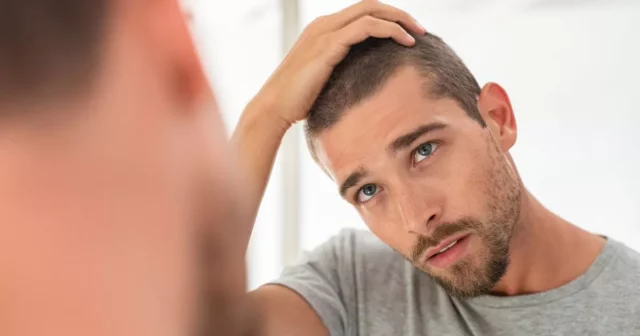Hair Loss in Young People: Causes, Treatments
For many, hair loss is often thought of as a problem linked only to ageing. However, hair loss in young people is becoming increasingly common. Men and women in their late teens, twenties, and thirties are experiencing thinning hair, bald patches, or excessive shedding. This can be distressing and have a significant impact on self-confidence, social life, and mental wellbeing. Understanding why young people suffer from hair loss — and what can be done to manage or reverse it — is the first step towards regaining control.
Why Does Hair Loss in Young People Happen?
There isn’t a single cause of hair loss in young people. Instead, a combination of genetic, lifestyle, hormonal, and environmental factors can play a role.
-
Genetic Predisposition (Androgenetic Alopecia)
The most common cause of young people hair loss is androgenetic alopecia, also known as male pattern baldness or female pattern hair loss. This hereditary condition can start as early as the late teens, with gradual thinning at the crown or hairline. Genetics determine how sensitive the hair follicles are to hormones like DHT (dihydrotestosterone), which shrinks follicles over time and leads to permanent loss.
-
Stress and Lifestyle Factors
University pressures, work demands, or personal struggles can trigger a condition called telogen effluvium. Stress forces hair follicles into a “resting phase,” causing excess shedding a few months later. Poor diet, smoking, and lack of sleep worsen the effects, as the body struggles to provide the nutrients hair needs to grow.
-
Hormonal Imbalances
Hormonal shifts also drive hair loss in young people. For women, conditions such as polycystic ovary syndrome (PCOS) or thyroid issues are common causes. Young men can also experience hormonal changes that affect follicle density and quality.
-
Medical Conditions and Medications
Some medical treatments or chronic conditions cause young people hair loss. Autoimmune conditions like alopecia areata can begin at any age, leading to patchy bald spots. Certain medications — including some for acne, depression, and high blood pressure — may also list hair loss as a side effect.
-
Hair Care Practices
Everyday grooming choices can contribute to hair loss in young people. Heat styling, bleaching, tight hairstyles (braids or ponytails), and harsh chemicals weaken follicles, leading to breakage and thinning.
What Can Be Done About Hair Loss in Young People?
The good news is that hair loss in young people doesn’t have to be permanent, especially if addressed early. A wide range of effective solutions exist — from non-surgical treatments to advanced transplant procedures.
-
Improve Lifestyle and Nutrition
A balanced diet rich in protein, zinc, iron, biotin, and vitamins A, D, and E supports healthy growth. Reducing stress through exercise, mindfulness, or counselling can prevent shedding linked to telogen effluvium.
-
Medical and Non-Surgical Treatments
- Minoxidil: A topical solution that stimulates hair growth and slows thinning.
- Finasteride (men only): Helps block DHT, the hormone linked to male pattern baldness.
- Platelet-Rich Plasma (PRP): Growth factors from your own blood stimulate follicle activity.
- Bio Light Therapy (BLT): FDA-approved laser therapy that improves scalp circulation and strengthens follicles.
-
Hair Transplant Surgery
In advanced cases of young people hair loss, FUE (Follicular Unit Extraction) offers permanent restoration by relocating healthy donor follicles. Modern FUE transplants create natural-looking density and restore lost confidence.
-
Professional Scalp Care
Specialist shampoos, serums, and strengthening products can reduce further damage and keep the scalp healthy. Many clinics combine scalp care with PRP or BLT for better results.
How UK Hair Transplants (UKHT) Supports Young Patients
At UK Hair Transplants (UKHT), we recognise how difficult hair loss in young people can be — especially when it impacts confidence at such a crucial stage of life. That’s why we provide treatments tailored to each individual.
- Comprehensive Diagnosis: We investigate the root cause of hair loss in young people through detailed medical and lifestyle assessments.
- Non-Surgical Options: UKHT offers advanced solutions such as PRP, BLT, and scalp therapies to slow and reverse early-stage thinning.
- Excellence in FUE: For permanent results, our surgeons perform up to 5,000 graft FUE transplants, ensuring natural, age-appropriate outcomes.
- Ongoing Aftercare: With 12 months of UK-based aftercare, patients benefit from reassurance, monitoring, and long-term support.
Why Consider a Hair Transplant?
Patients with hair loss in young people often choose a FUE hair transplant for:
- Permanent results: Transplanted follicles grow naturally for life.
- Natural appearance: Surgeons design hairlines that suit each patient’s age and face.
- Confidence boost: Restoring hair restores self-esteem and a youthful look.
- Low maintenance: Transplanted hair needs no special care beyond normal grooming.
Conclusion
Hair loss in young people is more common than many realise, often caused by genetics, stress, hormones, or lifestyle factors. The key is early action — the sooner treatment begins, the better the results. From lifestyle improvements and medical therapies to advanced surgical options, effective solutions are available for every stage.
At UKHT, we combine science, skill, and care to help young patients restore not just their hair, but also their confidence and quality of life. With the right approach, hair loss in young people doesn’t have to define your future.


